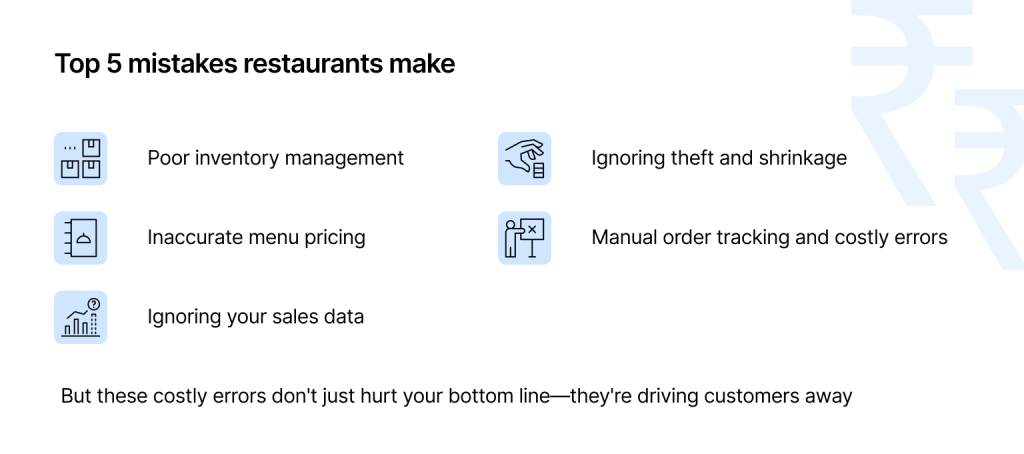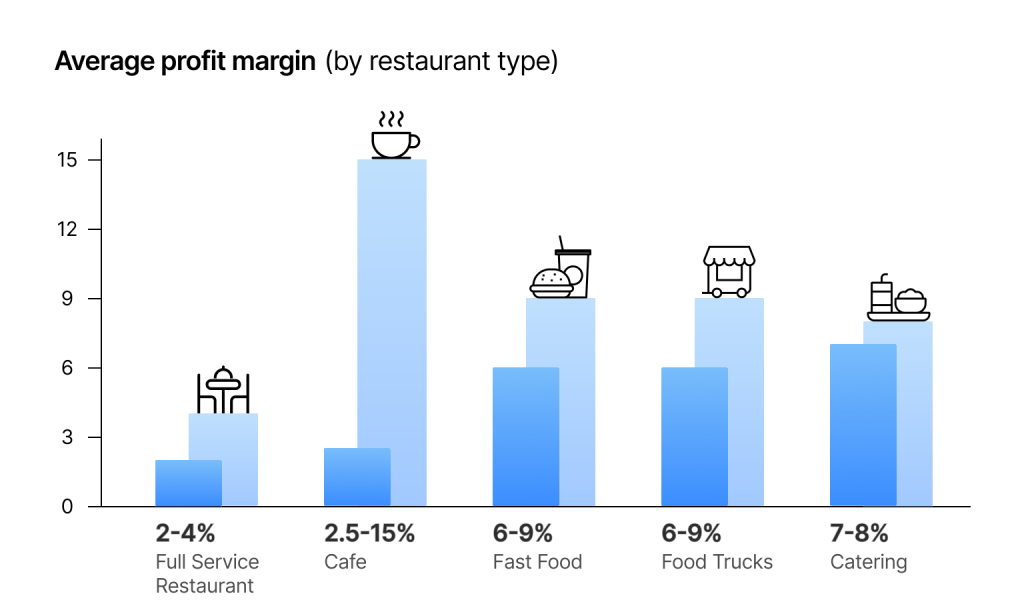Let’s be honest—running a restaurant is no small feat.
Restauranteurs juggle taste, service, and razor-thin margins—while trying to keep both customers and staff happy. However, even the top businesses can lose money through operational oversights, not just bad food or service.
Here are five avoidable mistakes that could be draining your profits—and how a modern Point of Sale (POS) system like Rista can help you fix them.

1. Poor Inventory Management
The Problem?
Over-ordering perishables or running out of bestsellers is a hidden yet widespread profit drain. Relying on manual inventory counts or “gut feeling” to place orders often results in surplus that blocks capital, increases waste, and inflates your COGS, directly cutting profit margins. At the same time, under-ordering leads to stock-outs, lost sales, and dissatisfied customers—potentially eroding long-term loyalty.
Restauranteurs often underestimate just how much inventory waste eats into profits: unused or spoiled ingredients are essentially cash thrown away. Effective inventory management—using data-driven systems rather than guesswork—helps restaurants minimize both overstock and shortages, optimizing cash flow and maximizing profitability.
The Impact?
Spoiled inventory means throwing away money. Stock-outs mean lost sales and disappointed customers who may not return.
How to Fix?
Investing in a smart POS system with inventory tracking can,
- Automate Inventory Counts: Track every ingredient and menu item in real time.
- Predict Demand: Use historical sales data to forecast needs for busy weekends, holidays, or seasonal events.
- Set Thresholds: Get alerts when items are running low, so you can reorder before you run out.
- Reduce Theft and Shrinkage: Monitor inventory discrepancies and spot patterns of loss.
Pro Tip 💡
| Integrate your POS with your suppliers for automatic reordering and to negotiate better rates based on actual usage. |
2. Inaccurate Menu Pricing
The Problem?
The majority of restaurateurs undertake menu engineering based on competitors’ pricing, gut feelings, or tradition instead of a detailed understanding of their own costs and profit targets. This approach can be costly, to say the least.
In 2025, the average restaurant food cost percentage—the portion of revenue spent on ingredients—ranges between 28% and 35%, depending on the restaurant type. Quick-service restaurants typically aim for 28-32%, casual dining averages around 30-34%, and fine dining can reach 32-35% due to premium ingredients and more complex preparations.
A study, however, proves that if your food cost exceeds 35%, it’s a clear indicator to rethink your pricing strategy, supplier contracts, or portion sizes to align with industry benchmarks.
For example, consider a restaurant that switches from serving an 8-ounce salad to a 7-ounce portion. While the one-ounce reduction may go unnoticed by most guests—especially if the plating and presentation remain appealing—the savings on ingredients’ costs add up quickly over hundreds or thousands of orders each month.

By making this subtle adjustment, the restaurant can boost its profit margins significantly while still delivering a satisfying dining experience.
The Impact?
You’re either overpricing (which drives customers away) or underpricing (which eats into margins).
How to Fix?
Leverage your POS to,
- Calculate True Food Costs: Factor in ingredient costs, labor, and overhead for each dish.
- Analyze Profit Margins: Identify which items are most profitable and which need a price adjustment.
- Monitor Ingredient Fluctuations: Adjust menu prices quickly when supplier costs change.
- Test and Optimize: Run limited-time offers or price changes and use POS data to see what works.
Pro Tip 💡
| Regularly review your menu performance. Drop or rework low-margin, slow-selling items. |
3. Ignoring Your Sales Data
The Problem?
When restaurants neglect their sales data, every decision—from which menu items to promote, to how to schedule staff—is based on assumptions rather than evidence. This lack of insight can lead to over-ordering, missing out on emerging trends, or failing to capitalize on best-selling dishes.
Sales data is a direct window into customer preferences, seasonal patterns, and the effectiveness of your promotions. Without digging into these details, you risk overlooking opportunities to optimize your menu, adjust pricing, or tailor marketing efforts to what your guests actually want.
The Impact?
You might overstock unpopular items, under-promote hidden gems, or miss out on upselling opportunities.
How to Fix?
Your POS can hold a goldmine of insights. Use it to,
- Identify bestsellers and underperformers
- Spot sales trends by time, day, or season
- Understand customer preferences and buying habits
Pro Tip 💡
| Use this data to plan specials, adjust staffing, and create targeted promotions that drive revenue. |
4. Ignoring Theft and Shrinkage
The Problem?
Overlooking theft and shrinkage is a far more widespread and costly problem in the restaurant industry than many owners realize. Internal theft accounts for a staggering 75% of all inventory loss in restaurants, according to a 2025 study by the National Restaurant Association.
In fact, about three out of every four employees admit to having stolen from their workplace at least once, and half of those do so repeatedly. Moreover, asset misappropriation, such as stealing food, drinks, or cash, is the most common form of employee theft, occurring in nearly 89% of cases.
The consequences go beyond just lost goods—rising food costs, unexplained inventory swings, and discrepancies in cash records are often the first signs of a deeper problem. For smaller teams, the risk is even higher: nearly a third of businesses with fewer than 30 employees report experiencing theft several times a week.
Over time, these “invisible” losses can erode already thin profit margins, making it even harder for restaurants to stay competitive in a challenging market.

The Impact?
Every missing drink or comped meal without reason chips away at your bottom line.
How to Fix?
Opt for a robust POS system that can,
- Limit access to discounts, voids, and comps to authorized managers
- Maintain detailed audit trails of every transaction
- Generate exception reports to flag suspicious activity
Pro Tip 💡
| Regularly review inventory consumption reports and conduct spot audits. Foster a culture of accountability among staff. |
5. Manual Order Taking and Costly Errors
The Problem?
Relying on handwritten tickets and verbal orders in a busy restaurant often leads to costly mistakes. Servers juggling multiple tables may write illegible or incomplete notes, while verbal orders can be misheard or forgotten amid the noise. These communication errors frequently cause incorrect dishes, missing special requests, and delayed or lost orders, all of which hurt efficiency and customer satisfaction.
The Impact?
The consequences of these errors go far beyond simple inconvenience. Incorrect orders lead to food waste, as dishes must be remade or discarded, which directly impacts your food costs. Guests who receive the wrong meal or experience delays are more likely to leave dissatisfied, potentially harming your restaurant’s reputation and reducing repeat business. Billing mistakes caused by manual entry errors can also lead to lost revenue or disputes at checkout, further complicating operations.
Moreover, these inefficiencies slow down service, increasing table turnover times and reducing overall capacity during peak hours. Without a reliable system to capture and transmit orders accurately and instantly, restaurants risk damaging both their bottom line and customer loyalty.
How to Fix?
A digital POS system with kitchen display screens (KDS) ensures order accuracy, faster service, and real-time updates.
- Sends orders instantly and accurately to the kitchen
- Reduces miscommunication between front and back of house
- Tracks prep times and order status in real time
Pro Tip 💡
| Use your POS to monitor ticket times and identify bottlenecks in your service flow. |
Final Thought
“Technology isn’t a luxury, but a lifeline.”
If you’re running your restaurant on gut feeling and guesswork, you’re leaving profits up to chance. A reliable, all-in-one POS system isn’t just about processing payments—it’s your partner in controlling costs, optimizing operations, and growing sustainably.
Start by auditing your current setup and processes. Even fixing just 2 or 3 of the above mistakes could significantly boost your bottom line.
Want to learn how the right POS can transform your restaurant’s profitability?